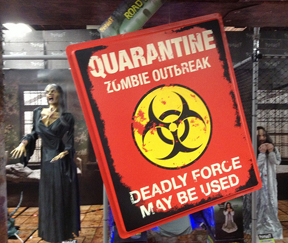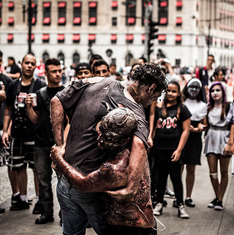Nature Boy lurches into the kitchen. Flu-ridden, his eyes are puffy and bloodshot, snot bubbles at his nostrils, and he breathes noisily through his mouth.
“Can I get you something?” I ask.
He reaches towards me, croaking something.
“I’m sorry, did you just say ‘brains’?”
_______________
Infectious disease plays a starring role in popular culture.
Anne Rice’s Vampire Chronicles, published from 1976 to 2014, provided diversity to the usual Dracula tale. Stephanie Meyer’s four-book, five-movie Twilight series features vampires and werewolves. Kathleen Peacock explores werewolves in her own series. And, of course, zombies are Hollywood staples.
These creatures of horror now appear in print, on film, and online. Nature Boy is addicted to TV’s new Fear the Walking Dead, and a friend uses the Zombies, Run app during her lunchtime jogs—“Run in the Real World. Become a Hero in Another.”
In almost all accounts, the creatures start out as ordinary folk like you and me. Then they become infected through gruesome encounters with the “undead,” who bite them/suck their blood/eat their brains. The infection turns the victims into something… no longer human. They became something to be feared, something that preys on innocent people, something that spreads infection.
These horror creatures boast centuries-old pedigrees. Pogroms occurred in Europe and the U.S. to stamp out flesh-eating, blood-swilling undead. As recently as 200 years ago, outbreaks of purported vampirism in New England were associated with tuberculosis deaths within single families. Common belief held that if a person died of TB, the corpse might feed on remaining family members. Prevention required the deceased’s heart and other vital organs be burned and mixed with medicine.
Rabies presents symptoms viewers of I Am Legend and World War Z would recognize. It causes weakness, low-grade fever, muscle spasms—including of the voice box—convulsions, numbness, as well as restlessness, delirium, abnormal behavior, and even hallucinations.
The discovery in the mid-1800s that bacteria and other microbes cause disease chased superstitions of the undead out the barn door. However, the folk tales and thrill endure.
In recent years, infectious-disease outbreaks have threatened us in reality. SARS created crises in Canada, the U.S., and Asia in 2004. Ebola, MERS, and influenza have strained public health resources in many countries. Measles and whooping cough are making comebacks. Resistant strains of E. coli, C. difficile, TB, Staphylococcus aurea, Salmonella, and other microbes chip away at our arsenals of antibiotics.
 Some public health organizations have harnessed pop-culture horror icons to spread messages about infection control and emergency preparedness. I Boost Immunity, a B.C. advocacy platform that supports immunization, recently published a series of posts examining movies, books and comics that have infected the pop-culture landscape. The U.S. Centre for Disease Control’s new graphic novel, Preparedness 101: Zombie Pandemic, provides information on how to prepare for both zombie attacks and real emergencies.
Some public health organizations have harnessed pop-culture horror icons to spread messages about infection control and emergency preparedness. I Boost Immunity, a B.C. advocacy platform that supports immunization, recently published a series of posts examining movies, books and comics that have infected the pop-culture landscape. The U.S. Centre for Disease Control’s new graphic novel, Preparedness 101: Zombie Pandemic, provides information on how to prepare for both zombie attacks and real emergencies.
Ultimately, however, the best way to control infections is to prevent them. Public health authorities in B.C. and elsewhere have standards to prevent and contain contagious illness. Key among these is the requirement that healthcare workers wash their hands before and after touching a patient or a patient’s immediate environment. This is one of the most effective ways to prevent spread of infections between patients and between patients and healthcare workers.
The Provincial Infection Control Network of BC began measuring hand-washing compliance at acute-care sites in the province in 2011. Last year was the first full year in which 80 per cent of healthcare workers in the province met hand-washing standards.
Of all healthcare workers, however, the agency found physicians were the least likely to scrub before and after seeing patients.
Of course, the standards set by health authorities apply only to public healthcare facilities. We can assist in preventing spread of infections elsewhere. We can stay home when we’re ill, and keep our kids home when they’re sick. We can store, clean and cook our food appropriately. We can cough or sneeze into tissues or our sleeves. And we, too, can wash our hands frequently.
These measures may not stop a zombie apocalypse or a vampire outbreak, but they may keep you from getting so sick, you feel like a zombie or vampire.
—30—
A version of this editorial appears in the October 18, 2015, Victoria Times Colonist.


You must be logged in to leave a reply.